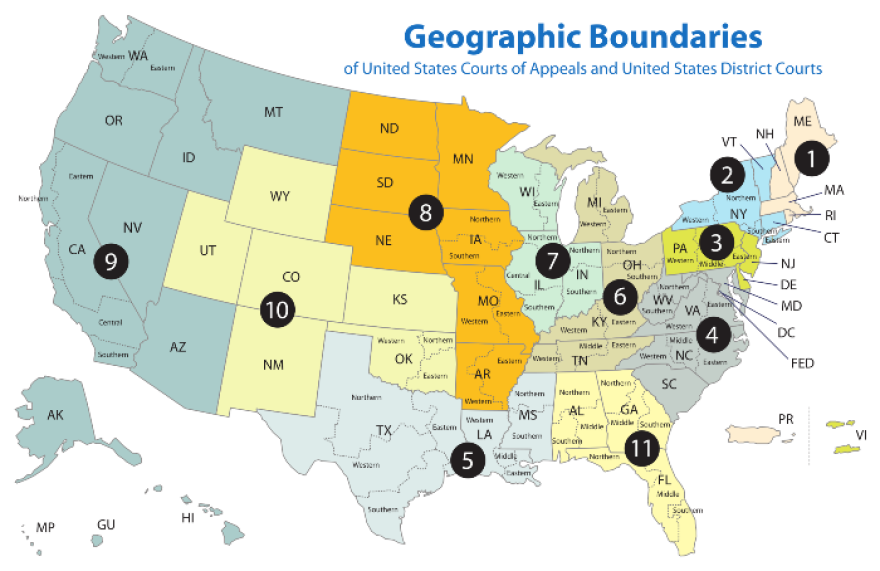Keeping track of federal court cases can be confusing even for reporters whose job it is to follow this stuff, let alone the general public. Lately, it seems there are a lot of major questions being decided by the courts (examples here, here, here, here and here).
To help you understand how cases move through the system, here’s a quick explainer. (We're mainly focusing on civil cases here — not criminal ones.)
District Courts
This is the first stop for most cases involving federal law, federal agencies or questions about the constitutionality of state laws.

Many states have more than one district court, split up by different regions of the state. For instance, Texas has four districts: Northern, Southern, Eastern and Western. Austin would be filed in U.S. District Court for the Western District of Texas. Districts are broken up into divisions — so there are federal courthouses all across the districts. The Western District of Texas goes from Austin all the way to El Paso, so there are courts in Austin, San Antonio, Waco, Midland, Del Rio, Pecos and El Paso.
There are several different judges in each courthouse, and cases are assigned to any of them. Most district courts assign cases at random, with some exceptions.
Sometimes, plaintiffs (the party bringing a case) will be strategic about which court they file a lawsuit in. They might believe they're more likely to get a sympathetic judge at a certain court — or a sympathetic appeal, if the case goes to the next level.

In cases challenging state or federal laws or actions, plaintiffs will file a complaint outlining their arguments and often a request for a temporary restraining order — which would temporarily halt whatever action they’re challenging while arguments are made. To extend that halt, plaintiffs can request a temporary injunction that will be in place while the case works its way through the courts. Those orders can be appealed to higher courts even before a trial on the whole case — or the merits of the case — is heard.
Typically, the district judge will hold hearings in these cases. There will often be oral arguments, where the parties go to the court and present their cases to the judge aloud. The judge will ask questions.
It can take weeks or months before the judge issues an opinion in a case.
At that point, the losing party can appeal to the Circuit Court of Appeals.
Circuit Courts of Appeals
Federal appeals courts are broken up into 12 regions — or circuits. Texas is in the Fifth Circuit, along with Louisiana and Mississippi. There's also a federal circuit, which handles very specific types of cases.

When a case is appealed to a court of appeals, it’s typically heard by a panel of three judges. Those judges will get written arguments from the parties and then hear oral arguments. There are no questioning of witnesses.
The judges will eventually issue an opinion. There are no time requirements for when they have to decide a case. Sometimes the judges are split — only two of them issue the majority opinion. The third judge can write his own opinion — or dissent — but it merely outlines why he did not join the majority.
The decision from the three-judge panel can be appealed to the entire appeals court — or en banc. This is when all judges in that appeals court re-hear and decide the case. These re-hearings are unusual and typically granted only when the opinion from the three-judge panel conflicts with an earlier ruling from that court or when the case deals with a “question of exceptional importance.”
Otherwise, the case is sent back to the district court to figure out how to implement the appeals court’s decision, if necessary.
At that point, the case can be appealed to the U.S. Supreme Court.
U.S. Supreme Court

A party in a lawsuit can appeal to the Supreme Court — but the chances of that court taking up the case are slim. The Supreme Court accepts only a few dozen out of the more than 10,000 appeals it gets each year. Usually, the court accepts a case — granting what’s called a writ of certiorari — only if a case is of major national importance or when similar cases have been decided differently by different appeals courts. Four of the court’s nine justices must agree to accept a case.
If the court declines to hear an appeal, the lower court's ruling stands as the final word.
Once the court accepts the case, lawyers submit written arguments. Sometimes other parties weigh in. Then the court holds oral arguments in the case. Usually, each side has 30 minutes to present their case and take questions from the justices. There are no witnesses. Typically it takes months for the court to issue a decision. The court hears cases only between October and April, and issues all opinions in those cases by the end of June.
If it doesn't decide the case outright, sometimes the court will send a case back to a lower court to implement the ruling or to rehear a case taking the justices’ guidance into account.
A case that goes through all these steps can take years to finally be decided. District courts and appeals courts have no time limits for deciding a case. The Supreme Court's timeline is self-imposed, but it can be up to a year between the time the high court accepts an appeal and it's heard and decided.


